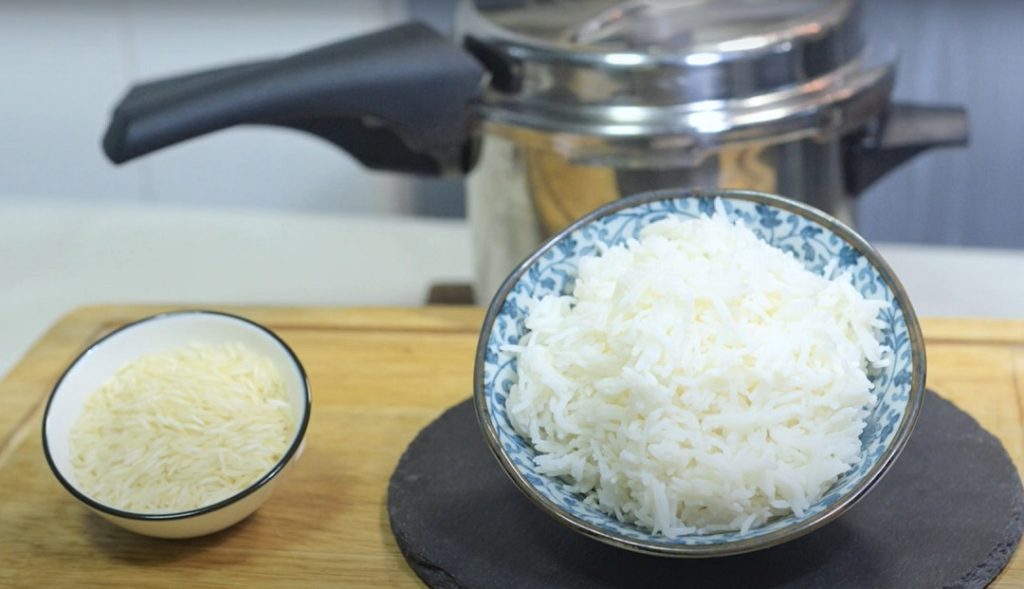
Introduction of Basmati Rice
Here, I will share with you a quick and easy way to cook fluffy Basmati rice in a pressure cooker. Using a pressure cooker allows you to prepare soft and fluffy rice much faster than the traditional method, making it a convenient option for enjoying delicious Basmati rice.
在这里,我将与大家分享如何在压力锅中以快捷简便的方式烹饪蓬松的印度香米。使用压力锅能够比传统方式更快地煮出松软的米饭,让你轻松享受美味的印度香米。
Ingredients:
- 200g Basmati rice (washed and soaked for 15 minutes)
- 300g water
食材:
- 200克印度香米(洗净并浸泡15分钟)
- 300克水
Instruction:
- Start by washing the Basmati rice thoroughly and then soak it in water for 15 minutes.
- After the soaking period, drain the water from the rice and transfer it to the pressure cooker. Add 300g of water.
- Turn on your induction cooker and set it to cook at 1600W.
- The first whistle from the pressure cooker will typically occur after about 4 minutes.
- Allow the pressure cooker to whistle about 5-6 times, which will take approximately 1 minute. Then, turn off the heat.
- Let the pressure cooker cool down, and the pressure inside will drop after 6-8 minutes.
- When removing the pressure cap, there should be no steam gusting out. (Caution: It is dangerous to open the cover if steam is still escaping from the pressure valve.)
- Open the pressure cooker’s lid and fluff the rice using a fork.
This quick and easy pressure cooker method will allow you to enjoy perfect Basmati rice in a short amount of time. There’s no need to wait too long, and each mouthful will be filled with the delightful aroma and texture of Basmati rice. Enjoy!
做法:
- 将印度香米洗净,并浸泡在水中15分钟。
- 将浸泡好的印度香米沥干水分后倒入压力锅中,然后加入300克水。
- 打开电磁炉,开始烹饪(功率1600W)。
- 大约4分钟后,将听到第一声响声。
- 让压力锅响5-6次,大约需要1分钟,然后关闭电源。
- 让其冷却,大约6-8分钟后,压力将会降至室温。
- 打开压力锅盖时,不应有蒸汽涌出。(注意:如果在打开盖子时仍然有蒸汽从压力阀中涌出,这是危险的,不可打开盖子)。
- 打开锅盖,用叉子拨松米饭。
这个快捷简便的压力锅烹饪方法将让您在短时间内享受到美味的蓬松印度香米。无需等待太长时间,这款食谱将带给您完美的印度香米,一口一口都充满了香气和口感的享受。愿大家喜欢!
Video:
More Video
The Rich History of Basmati Rice
Basmati rice, renowned for its fragrant aroma, slender grains, and delicate flavor, has a rich history that spans centuries and is deeply intertwined with the culture, heritage, and agriculture of the Indian subcontinent. This long-grain rice variety is often considered the “King of Rice” due to its exceptional quality and significance.
The story of Basmati rice begins in the foothills of the Himalayas, particularly in the regions of India and Pakistan. It is believed that Basmati rice has been cultivated in the Indian subcontinent for over 2,000 years. The name “Basmati” is derived from the Sanskrit word “vasmati,” meaning fragrant. This name is a testament to the rice’s distinctive aroma, which is often described as nutty or floral.
Historical records indicate that Basmati rice was cultivated in the northwestern parts of the Indian subcontinent, where the combination of fertile soil, clean water from Himalayan rivers, and a favorable climate provided the ideal conditions for its growth. The rice was highly regarded not only for its enticing aroma but also for its long, slender grains that remained separate when cooked. This made it a preferred choice for lavish feasts, particularly during the Mughal era in India.
The Mughal emperors, who ruled India from the early 16th to the mid-19th century, were known for their appreciation of fine arts and cuisine. They cultivated Basmati rice in their royal gardens and made it a centerpiece of their culinary traditions. This contributed to the rice’s prestige and widespread recognition.
In addition to its culinary significance, Basmati rice also played a role in trade and diplomacy. It became a valuable commodity that was exported to various regions, including Persia (modern-day Iran) and Central Asia, establishing trade links and cultural exchanges. Basmati rice was not only a source of sustenance but also a symbol of prosperity and the opulence of the Indian subcontinent.
The uniqueness of Basmati rice is attributed to its growth in specific regions and the indigenous farming techniques passed down through generations. The rice is typically cultivated in the states of Punjab, Haryana, and Uttar Pradesh in India, and in certain regions of Pakistan. The combination of the soil’s mineral content, the pure water from the Himalayan rivers, and the climate creates the perfect conditions for Basmati rice to flourish.
As Basmati rice’s reputation spread globally, it received recognition and protection as a Geographical Indication (GI) product. This legal recognition safeguards the authenticity of Basmati rice and ensures that only rice grown in the designated regions can bear the name “Basmati.”
Over the years, Basmati rice has evolved in response to changing agricultural practices and the demands of modern consumers. Today, it is a staple in Indian and Pakistani households, as well as in many other parts of the world. Basmati rice has become a versatile ingredient in various international cuisines, from biryanis and pilafs to sushi and risottos.
In conclusion, the history of Basmati rice is a testament to the deep connection between agriculture, culture, and culinary traditions in the Indian subcontinent. Its exceptional aroma, delicate flavor, and long grains have made it an integral part of both everyday meals and special occasions. As Basmati rice continues to enchant palates worldwide, it remains a symbol of the region’s agricultural prowess and cultural heritage.
Basmati香米的丰富历史
以其芳香气味、纤细颗粒和细腻口感而闻名,拥有数百年的悠久历史,深刻融入了印度次大陆的文化、遗产和农业。这种长粒大米常被誉为“大米之王”,因其卓越品质和重要性而备受推崇。
Basmati香米的故事始于喜马拉雅山脚下,尤其是印度和巴基斯坦地区。相传香米在印度次大陆已经有两千多年的种植历史。”Basmati”这个名字源自梵文单词”vasmati”,意为芬芳。这个名字见证了大米独特的香气,通常被形容为坚果或花香。
历史记录显示,香米在印度次大陆西北部地区的种植得到了发展,那里的肥沃土壤、喜马拉雅山脉的洁净河水和适宜的气候提供了理想的生长条件。这种大米不仅因其引人入胜的香气,还因其在烹饪后能保持独立的纤细颗粒而备受推崇。这使得它成为盛宴的首选,尤其是在印度莫卧儿帝国时期。
莫卧儿帝国统治印度约三个世纪,以其对美术和烹饪的喜好而著称。他们在皇家花园中种植香米,将其作为他们烹饪传统的中心。这为大米的声誉和广泛认可做出了贡献。
除了在烹饪上的重要性,香米还在贸易和外交中扮演了角色。它成为了一种宝贵的商品,出口到包括波斯(今伊朗)和中亚等多个地区,建立了贸易联系和文化交流。香米不仅是食物来源,也是繁荣和印度次大陆富饶的象征。
Basmati香米的独特性归因于其在特定地区的种植和代代相传的农业技术。通常,香米在印度的旁遮普、哈里亚纳和北方邦等地区,以及巴基斯坦的某些地区种植。土壤中的矿物质、来自喜马拉雅山的纯净河水和气候的结合创造了香米蓬勃生长的理想条件。
随着Basmati香米的声誉在全球传播,它获得了地理标志(GI)产品的法律认可。这种法律认可保护了香米的真实性,确保只有在指定地区种植的大米才能使用”香米”这一名称。
多年来,为了适应不断变化的农业实践和现代消费者的需求,香米也发生了改变。如今,它是印度和巴基斯坦家庭的主食,也是世界各地许多其他地方的主食。香米已成为各种国际美食的多才多艺的成分,从印度的比尔扬尼和炖饭到寿司和意大利烩饭。
总之,Basmati香米的历史证明了印度次大陆的农业、文化和烹饪传统之间的深刻联系。其卓越香气、细腻风味和长粒颗粒使其成为日常餐饮和特殊场合的重要组成部分。随着香米继续吸引全球人们的味蕾,它仍然是该地区农业实力和文化遗产的象征。
